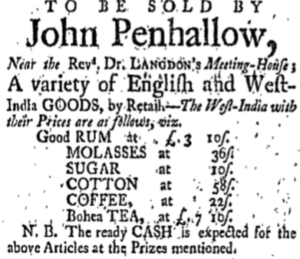Were their hands clean? Are my hands clean?
Overview
Students examine Portsmouth, NH, shipping news, maps, and local store advertisements from the 18th and 19th centuries to consider how people in our local communities were connected to the triangle trade. They then reflect on how their own economic choices are related to exploitation and other global issues.
Topics
Triangle Trade, Transatlantic Slave Trade, Slavery in the North
Enduring Understanding
Slavery existed in the North and was central to the development and growth of the northern economies.
Compelling Question
How were our communities connected to the triangle trade?
Historical Thinking Skills
Sourcing and Evidence; Synthesizing Sources
Lesson Outline
Activating Prior Knowledge/Building Historical Context
Review the triangle trade, familiarizing students with the geography and history of the triangle trade. Review goods that were typically traded between New England and the West Indies. Triangular Trade map worksheet
Background: It is important for students to understand the economic connections between New England and the West Indies. Our region supplied the slave societies of the Caribbean with food such as corn, beans, oats, hay, hogs, turkeys, and potatoes, while they supplied us with molasses and sugar, which was distilled into Rum.
Investigation of Primary Sources
Examine a shipping news advertisement from a 1768 Portsmouth newspaper. Source the document and connect the ingoing and outgoing ships to the triangular trade map. Shipping News worksheet
Examine advertisements from Vermont newspapers and identify West Indies goods being sold in Vermont stores. Note the goods being received in Norwich (including wheat and produce)–New England provisioned the West Indies with food, livestock and, later, manufactured goods such as shoes and tools. Hand out the Triangle Trade Worksheet, along with one of the advertisements to pairs of students to read and analyze. Triangle Trade worksheet and advertisements
Students could search in Chronicling America for West Indies goods being sold in their own communities.
Summative Assessment
Explanatory Essay: After examining local store advertisements, explain how local community members were connected to the triangle trade.
| Extension |
| Review the term exploitation: The action or fact of treating someone unfairly in order to benefit from their work.
Listen to Are my hands clean? Have students identify an issue they care about, such as exploitation, climate change or child labor, and consider how their clothing or other purchases connect. Students write a reflection on how their own economic choices are connected to exploitation and other global issues. |
Worksheets and Primary Sources Used in the Lesson
Triangular Trade map worksheet
Triangle Trade Merchant worksheet
Additional Information: The Triangle Trade
New England and the African Slave Trade
Film: Traces of the Trade—about a New England family that traces their connection to enslavement.
Contemporary Connections
Between a Rock and a Hard Pace: A history of American Sweatshops 1820 – Present
